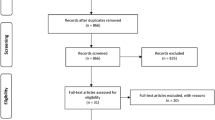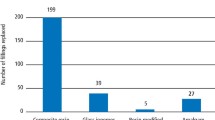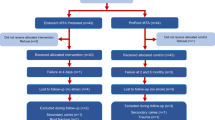Key Points
-
Success rates were found to be higher in teeth restored with stainless steel crowns than in teeth restored with amalgam.
-
Amalgam is a suitable alternative to a stainless steel crown only for teeth with mechanically exposed pulp.
-
Pulpotomy success rates are higher in teeth with pinpoint carious exposure.
-
Under the conditions of this study, restoration failure did not appear to affect treatment prognosis.
Abstract
Objectives To compare the success rate of calcium hydroxide (Ca(OH)2) pulpotomies in primary molars restored with a stainless steel crown (SSC) to that of teeth restored with amalgam and to evaluate the role of restoration failure in treatment outcome. Study design Pulpotomies were performed in 154 primary molars. Teeth were grouped according to pulpal exposure type as either mechanically or cariously exposed, with cariously exposed teeth further divided according to size of exposure site (pinpoint or larger than pinpoint). Seventy teeth were restored with amalgam and 84 with a SSC. Teeth were followed up for 12 months. Results Pulpotomy success rates were 79.9% for teeth restored with a SSC and 60% for those restored with amalgam. The difference between these rates was statistically significant (p <0.01). Restoration failure rates were 14.3% for amalgams and 2.4% for SSCs. The difference between these rates was also statistically significant (p <0.01). Among the 12 failed restorations, treatment was found to be successful in five cases (41.7%) and unsuccessful in seven cases (58.3%). This difference was not statistically significant (p >0.05). Conclusions The pulpotomy success rate for teeth restored with a SSC was higher than for those restored with amalgam. Restoration failure did not appear to have an effect on treatment prognosis.
Similar content being viewed by others
Log in or create a free account to read this content
Gain free access to this article, as well as selected content from this journal and more on nature.com
or
References
Massler M. Preventive endodontics: vital pulp therapy. Dent Clin North Am 1967; Nov: 663–673.
Kopel H M. Considerations for the direct pulp capping procedure in primary teeth: a review of the literature. ASDC J Dent Child 1992; 59: 141–149.
Waterhouse P J, Nunn J H, Whitworth J M . An investigation of the relative efficacy of Buckley's formocresol and calcium hydroxide in primary molar vital pulp therapy. Br Dent J 2000; 188: 32–36.
Waterhouse P J, Nunn J H, Whitworth J M, Soames J V . Primary molar pulp therapy - histological evaluation of failure. Int J Paediatr Dent 2000; 10: 313–321.
Fuks A B. Current concepts in vital primary pulp therapy. Eur J Pediatr Dent 2002; 3: 115–120.
Stanley H R, Pameijer C H . Dentistry's friend: calcium hydroxide. Oper Dent 1997; 22: 1–3.
Guelmann M, Fair J, Turner C, Courts F J . The success of emergency pulpotomies in primary molars. Pediatr Dent 2002; 24: 217–220.
Camp J H. Pulp therapy for primary and young permanent teeth. Dent Clin North Am 1984; 28: 651–668.
McDonald R E, Avery D R, Dean J A . Treatment of deep caries, vital pulp exposure and pulpless teeth. In McDonald R E, Avery D R (eds) Dentistry for the child and the adolescent. 7th ed. pp 413–437. St.Louis: Mosby, 2000.
Davina A B. A conservative approach to the pulpotomy in primary teeth. J Clin Pediatr Dent 1998; 22: 103–105.
El-Kalla I H, Garcia-Godoy F. Fracture strength of adhesively restored pulpotomized primary molars. ASCD J Dent Child 1999; 66: 238–242.
Droter J A. Pulp therapy in primary teeth. J Dent Child 1967; 34: 507–510.
Starkey P E. Management of deep caries and pulpally involved teeth in children. In Goldman H M (ed) Current therapy in dentistry. pp 896–932. St Louis: Mosby, 1968.
Croll T P, Killian C M . Zinc oxide-eugenol pulpotomy and stainless steel crown restoration of a primary molar. Quintessence Int 1992; 23: 383–388.
Seale N S. The use of stainless steel crowns. Pediatr Dent 2002; 24: 501–505.
Guelmann M, McIlwain M E, Primosch R E . Radiographic assessment of primary molar pulpotomies restored with resin-based materials. Pediatr Dent 2005; 27: 24–27.
Doyle W A, McDonald R E, Mitchell D F . Formocresol versus calcium hydroxide in pulpotomy. ASDC J Dent Child 1962; 29: 86–97.
Heilig J, Yates J, Siksin M, McKnight J, Turner J . Calcium hydroxide pulpotomy for primary teeth: a clinical study. J Am Dent Assoc 1984; 108: 775–777.
Mathewson R J, Primosch R E . Pulp treatment. In Mathewson R J, Primosch R E (eds) Fundamentals of pediatric dentistry. 3rd ed. pp 257–280. Chicago: Quintessence, 1995.
Fishman S A, Udin R D, Good D L, Rodef F . Success of electrofulguration pulpotomies covered by zinc oxide and eugenol or calcium hydroxide: a clinical study. Pediatr Dent 1996; 18: 385–390.
Gruythuysen R J, Weerheijm K L . Calcium hydroxide pulpotomy with a light-cured cavity sealing material after two years. ASDC J Dent Child 1997; 64: 251–253.
Eidelman E, Holan G, Fuks A B . Mineral trioxide aggregate vs. formocresol in pulpotomized primary molars: a preliminary report. Pediatr Dent 2001; 23: 15–18.
Sasaki H, Ogawa T, Koreeda M, Ozaki T, Sobue S, Ooshima T . Electrocoagulation extends the indication of calcium hydroxide pulpotomy in the primary dentition. J Clin Pediatr Dent 2002; 26: 275–278.
Agamy H A, Bakery N S, Mounir M M, Avery D R . Comparison of mineral trioxide aggregate and formocresol as pulp-capping agents in pulpotomized primary teeth. Pediatr Dent 2004; 26: 302–309.
Schroeder U. A 2-year follow-up of primary molars pulpotomized with a gentle technique and capped with calcium hydroxide. Scand J Dent Res 1978; 86: 273–278.
Schroeder U, Szpringer-Nodzak M, Janicha J, Wacinska M, Budny J, Mlosek K . A one-year follow-up of partial pulpotomy and calcium hydroxide capping in primary molars. Endod Dent Traumatol 1987; 3: 304–306.
Goldberg F, Massone E J, Spielberg C . Evaluation of the dentinal bridge after pulpotomy and calcium hydroxide dressing. J Endod 1984; 10: 318–320.
Özata F, Pişkin B, Erdilek N, Aktener O, Tuncer A V . Comparison of calcium hydroxide and formocresol pulpotomies in primary teeth in lambs: preliminary study. J Endod 1987; 13: 328–335.
Fadavi S, Anderson A W . A comparison of the pulpal response to freeze dried bone, calcium hydroxide and zinc oxide-eugenol in primary teeth in two cynomolgus monkeys. Pediatr Dent 1996; 18: 52–56.
Osborne J W, Summitt J B, Roberts H W . The use of dental amalgam in pediatric dentistry: review of the literature. Pediatr Dent 2002; 24: 439–447.
Markovic D, Zivojinovic V, Vucetic M . Evaluation of three pulpotomy medicaments in primary teeth. Eur J Paediatr Dent 2005; 6: 133–138.
Troutman K C, Reisbick M H, Berson R B, Good D L, Gutmann J l. Pulp therapy. In Stewart R E, Barber T K, Toutman K C, Wei SHY (eds) Pediatric dentistry: scientific foundations and clinical practice. pp 908–941. St. Louis: Mosby Company, 1982.
Holan G, Fuks A B, Keltz N . Success rate of formocresol pulpotomy in primary molars restored with stainless still crown vs amalgam. Pediatr Dent 2002; 24: 212–216.
Via W F Jr. Evaluation of deciduous molars treated by pulpotomy and calcium hydroxide. J Am Dent Assoc 1955; 50: 34–43.
Eidelman E, Touma B, Ulmansky M . Pulp pathology in deciduous teeth: clinical and histological correlations. Isr J Med Sci 1968; 4: 1244–1248.
Fuks A B. Pulp therapy for the primary and young permanent dentitions. Dent Clin North Am 2000; 44: 571–596.
Hobson P. Pulp treatment of deciduous teeth. 1. Factors affecting diagnosis and treatment. Br Dent J 1970; 128: 232–238.
Rayner J A, Southam I I . Pulp changes in deciduous teeth associated with deep carious dentin. J Dent 1979; 7: 39–42.
Farooq N S, Coll J A, Kuwabara A, Shelton P . Success rates of formocresol pulpotomy and indirect pulp therapy in the treatment of deep dentinal caries in primary teeth. Pediatr Dent 2000; 22: 278–286.
Holland I S, Walls A W, Wallwork M A, Murray J J . The longevity of amalgam restorations in deciduous molars. Br Dent J 1986; 161: 255–258.
Camp J H, Barrett E J, Pulver F . Pediatric endodontics: endodontic treatment for the primary and young permanent dentition. In Cohen S, Burns R C (eds) Pathways of the pulp. 8th ed. pp 797–816. St. Louis: Mosby, 2002.
Cvec M. A clinical report on partial pulpotomy and capping with calcium hydroxide in permanent incisors with complicated crown fractures. J Endod 1978; 4: 232–237.
Pereira J C, Stanley H R . Pulp capping: influence of the exposure site on pulp healing - histologic and radiographic study in dogs' pulp. J Endod 1981; 7: 213–223.
Greeley M C B. Pulp therapy for the primary and the young permanent dentition. In Forrester D C, Wagner M L, Fleming J (eds) Pediatric dental medicine. pp 456–460. Philedelphia; Lea & Febiger, 1981.
Magnusson B O. Pulpotomy in primary molars: long-term clinical and histological evaluation. Int Endod J 1980; 13: 143–155.
Cox C F, Bergenholtz G, Fitzgerald M et al. Capping of the dental pulp mechanically exposed to the oral microflora – a 5 week observation of wound healing in the monkey. J Oral Pathol 1982; 11: 327–339.
Mejare I. Pulpotomy of primary molars with coronal or total pulpitis using formocresol technique. Scand J Dent Res 1979; 87: 208–216.
Holan G, Eidelman E, Fuks A B . Long-term evaluation of pulpotomy in primary molars using mineral trioxide aggregate or formocresol. Pediatr Dent 2005; 27: 129–136.
Browne R M, Tobias R S . Microbial microleakage and pulpal inflammation: a review. Endod Dent Traumatol 1986; 2: 177–183.
Pashley E L, Tao L, Pashley D H . The sealing properties of temporary filling materials. J Prosthet Dent 1988; 60: 292–297.
Stanley H R. Pulp capping: conserving the dental pulp – can it be done? Is it worth it? Oral Surg Oral Med Oral Pathol 1989; 68: 628–639.
Braff M H. A comparison between stainless steel crowns and multi-surface amalgams in primary molars. ASDC J Dent Child 1975; 42: 474–478.
Roberts J F, Sheriff M . The fate and survival of amalgam and preformed restorations placed in a specialist paediatric dental practice. Br Dent J 1990; 169: 237–244.
Randall R C. Preformed metal crowns for primary and permanent molar teeth: review of the literature. Pediatr Dent 2002; 24: 489–500.
Al-Zayer M A, Straffon L H, Feigal R J, Welch K B . Indirect pulp treatment of primary posterior teeth: a retrospective study. Pediatr Dent 2003; 25: 29–36.
Fuks A B, Jones P C, Michaeli Y, Bimstein E . Pulp response to collagen and gluteraldehyde in pulpotomized primary teeth of baboons. Pediatr Dent 1991; 13: 142–150.
Acknowledgements
We would like to thank to Professor Fikret Gurbuz for his kind help with the statistical analysis in this study.
Author information
Authors and Affiliations
Corresponding author
Additional information
Refereed paper
Rights and permissions
About this article
Cite this article
Sonmez, D., Duruturk, L. Success rate of calcium hydroxide pulpotomy in primary molars restored with amalgam and stainless steel crowns. Br Dent J 208, E18 (2010). https://doi.org/10.1038/sj.bdj.2010.446
Accepted:
Published:
Issue date:
DOI: https://doi.org/10.1038/sj.bdj.2010.446
This article is cited by
-
Evaluation of the reasons for failure in teeth with vital amputation treatment
BMC Oral Health (2023)
-
Clinical effectiveness of restorative materials for the restoration of carious lesions in pulp treated primary teeth: a systematic review
European Archives of Paediatric Dentistry (2022)
-
The evaluation of MTA and Biodentine as a pulpotomy materials for carious exposures in primary teeth
Clinical Oral Investigations (2019)
-
Long-term effectiveness of four pulpotomy techniques: 3-year randomised controlled trial
Clinical Oral Investigations (2012)



